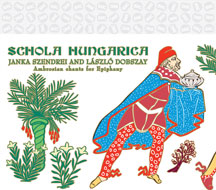Product Details
- An MVD Exclusive
- SKU: BMCCD165
- Format: CD
- UPC: 5998309301650
- Street Date: 03/19/10
- PreBook Date: 01/01/01
- Label: BMC Records »
- Genre: Classical
- Run Time: 63 mins
- Number of Discs: 1
- Year of Production: 2008
- Box Lot: 25
- Territory: NA,GB,AU
Product Assets
Schola Hungarica / Dobszay, Laszlo / Szendrei, Janka - Ambrosian Chants For Epiphany

- List Price: $15.99
- Your Price: $15.99
- In Stock: 3
You must login to place orders.
The patriarchal city of Milan traces its liturgy and liturgical music back to the great doctor of the church, Saint Ambrose. The Ambrosian liturgy named after him is a sister to the Roman, with many common but many differing traits. The material on this disc presents music for the mass and vespers for Epiphany. Compared to Gregorian, Ambrosian music is much richer in embellishment and melisma. Frequently, pausing on one syllable, long melodies without clearly articulated texts are interpolated. True enough, in the simple genres such as the office antiphon, Ambrosian is even simpler than Gregorian. On special but attractive feature of Ambrosian chant is the use of tonalities, and the exposure of one or two unusual intervals, especially the tritone (F-B, for instance). The ordinary parts of the mass are taken from a Christmas composition by a Milan cathedral choirmaster of the early Renaissance, Franchino Gafurio (1451-1522). He was a renowned music theorist in his time, and his works, though they may not attain the standard expected of recognized composers, are decently written polyphonic pieces, interesting to hear. After the Ingressa we sing the Gloria (2), before the Offertorium is the Credo (8), after it is the Sanctus (10), and between the Confractorium and the Transitorium is heard the Agnus (12). Both the Sanctus and the Agnus, and also the Kyrie at the end of the disc, are extended with inserts, known as tropes, on Christmas themes.
Track Listing
|
|
Press Quotes
It is certainly not the first time that we present this excellent ensemble in these columns, but it is each time a happy event. All those who retain the melancholy memories of endless Sunday masses during which the parochial choir debated a song of ceremonial slowness and approximate vagueness, will have the opportunity here to reconcile with this fabulous heritage. We are surprised by the virtuosity and energy upgraded by the Schola Hungarica to defend this treasure. The alternation between plain-song and polyphony is extremely effective, which accentuates and increases the intrinsic specificities of each genre, while the responsorial singing brings a moment of relaxation. In short, this is a very beautiful realization that makes us discover with happiness a heritage come from the dawn of time.
—PiRath, Pizzicato (Luxembourg), September 2010
